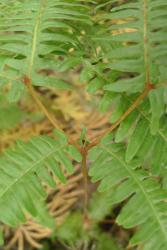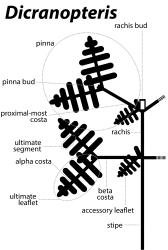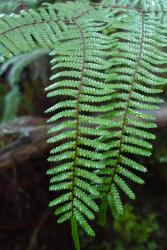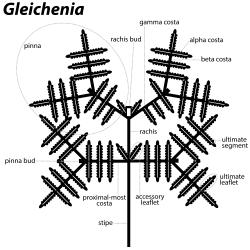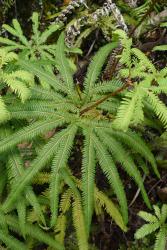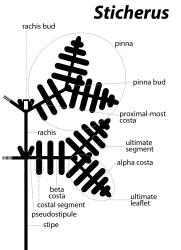Terrestrial ferns. Rhizomes creeping, scaly or hairy. Fronds monomorphic, not articulated to rhizome, of determinate (not NZ) or indeterminate growth (NZ) in adults. Stipes scaly or hairy, but often glabrescent. Rachis with pinnate lamina (not NZ), or absent with a single pair of pinnae (not NZ), or reduced to a bud at the apex of the stipe with a single pair of pinnae (NZ); rachis buds sometimes extending to produce another tier comprising a rachis terminating in another rachis bud and pair of pinnae. Pinnae unforked or forking pseudodichotomously 1-several times; buds at bifurcations sometimes extending 1-several times. Veins free. Sporangia in sori; exindusiate. Sporangia with oblique annulus and ± defined stomium; maturing ± simultaneously; 128–1000 spores per sporangium. Homosporous; spores monolete or trilete, plain or rugulate, sometimes perforate or rarely reticulate, lacking chlorophyll.
A family of six genera and about 140 species.
Allan (1961) placed New Zealand plants now attributed to Dicranopteris, Gleichenia, and Sticherus into a broadly-circumscribed Gleichenia. Recent treatments generally accept six genera in the Gleicheniaceae, encompassing the New Caledonian endemic Stromatopteris and segregating the neotropical Gleichenella from Dicranopteris (Smith et al. 2006; Christenhusz et al. 2011). Stromatopteris is apparently most closely related to Gleichenia and Sticherus (Schuettpelz & Pryer 2007), rendering untenable the recognition of Stromatopteris as one of two subfamilies (Kramer 1990).
| 1 | Ultimate segments <3 mm long, bearing no more than one sorus each; ultimate leaflets arranged pinnately on β costae | Gleichenia |
| Ultimate segments >4 mm long, bearing >2 sori each; ultimate leaflets branched pseudodichotomously from β costae | 2 | |
| 2 | Axes subtending the pseudodichotomously-branched ultimate leaflets (i.e., the β costae) lacking costal segments; 7–12 sporangia per sorus; ultimate segments with veins between midvein and margin branched more than once; scales absent from lamina and rhizome | Dicranopteris |
| Axes subtending the pseudodichotomously-branched ultimate leaflets (i.e., the β costae) bearing costal segments; 3–5 sporangia per sorus; ultimate segments with veins between midvein and margin branched only once; scales present, always evident on rhizome, but sometimes hair-like on lamina | Sticherus |
The frond architecture of Gleicheniaceae is strikingly different to all other fern families. Most Gleicheniaceae have a rachis of indeterminate growth (often confined, at least initially, to a resting bud) and pinnae that branch pseudodichotomously and which may extend indeterminately from buds between the pseudodichotomies. Stromatopteris is a notable exception to these characters, while Diplopterygium lacks the pseudodichotomous branching of the pinnae. The family is also characterised by exindusiate sori of few (2–20) sporangia.
Distributed throughout tropical and subtropical regions, extending also into southern temperate regions. Three genera and at least nine species in New Zealand; two species endemic.
| Category | Number |
|---|---|
| Indigenous (Endemic) | 2 |
| Indigenous (Non-endemic) | 8 |
| Total | 10 |
The terminology of Shaw & Ranker (2011) is used to describe the often pseudodichotomously-branching and indeterminate frond architecture in the Gleicheniaceae; the most pertinent terms for characterising the New Zealand taxa are described below (also see Figs. 2, 4, 6).
The distal, or outer-most, axes of the frond are termed α costae; moving progressively inwards towards the stipe are β costae, γ costae, δ costae, etc. We have used proximal-most costa to refer to the axis that connects each pinna to the central stipe/rachis axis; the proximal-most costa may be an α, β, γ, δ, etc. costa, depending on how divided the pinna is.
The smallest units of the lamina are termed ultimate segments (on α costae) or costal segments (on other costae). The ultimate segments of Gleichenia measure c. 1–2 mm long, 1–2 mm wide, whereas those of Dicranopteris and Sticherus are larger, 5–55 mm long, 1–4.5 mm wide, and distinctly oblong or linear. Ultimate segments are borne pinnatisectly on an α costa; an α costa with its ultimate segments comprises an ultimate leaflet. Gleichenia differs significantly in its frond architecture from the other genera in New Zealand in that its ultimate leaflets are arranged pinnately on a β costa (or a γ costa etc.); in Dicranopteris and Sticherus, the ultimate leaflets branch pseudodichotomously from the distal end of a β costa. Costal segments are like ultimate segments but borne on axes other than an α costa. Costal segments are absent from Dicranopteris (except those subtending a rachis or pinna bud) and Gleichenia, but are borne pinnatisectly on β costae, γ costae, etc. in Sticherus.
In many species of Gleicheniaceae the rachis initially comprises only a bud, situated at the apex of the stipe and flanked by a pair of pinnae. This rachis bud may be subtended by pseudostipules and/or accessory leaflets. A pseudostipule resembles an ultimate segment. An accessory leaflet resembles an ultimate leaflet, or can be even more divided. In New Zealand, Gleichenia may have accessory leaflets that are often proximally branched, Sticherus may have pseudostipules that may be proximally branched or lobed, and Dicranopteris has an accessory leaflet paired with a costal segment.



